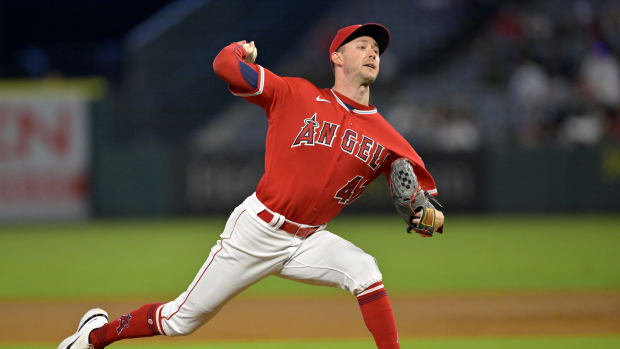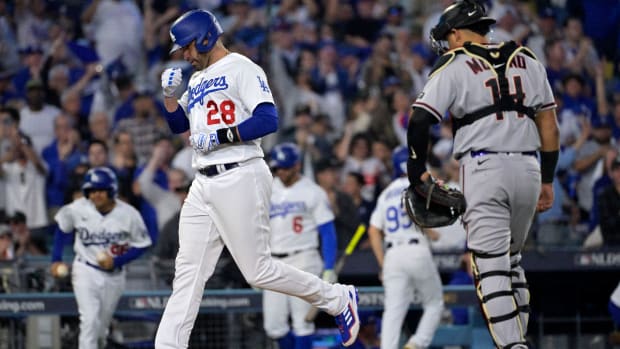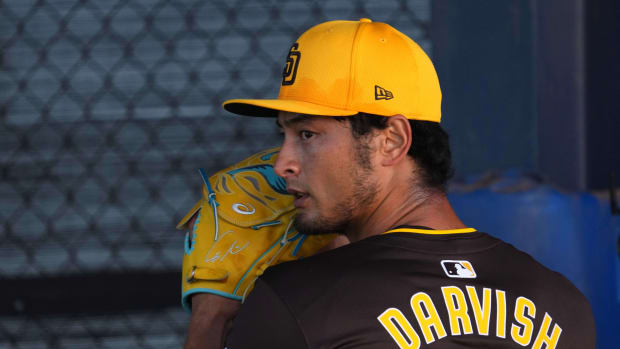The Real Steal
He is a foreign-born, 28-year-old southpaw who's just over six feet tall. He has the ability to flummox lefthanded and righthanded hitters alike with a stunning mix of power and finesse. He has become, says an American League general manager, "an annual Cy Young candidate," and one who was available this off-season to any deep-pocketed and prospect-rich club interested in adding a top-of-the-rotation ace. He is not, however, Johan Santana, the erstwhile Minnesota Twin.
He is Erik Bedard, who was born seven days before Santana in March 1979 and last year proved that he can wreak Santana-like havoc on hitters. He tied Santana (and two others) for fifth in the AL Cy Young voting, and would likely have challenged C.C. Sabathia for the award had a strained right oblique not cost him the final five weeks of the season. Only eight starters in the history of the game have had a season in which they struck out more batters per nine innings than the 10.93 Bedard averaged last year for the Baltimore Orioles. Just three -- Randy Johnson, Pedro Martinez and Curt Schilling -- have done so while topping Bedard's strikeout-to-walk ratio of 3.88 to 1. Most of his other key statistics in 2007 compared favorably with Santana's: Pitching for a worse team, Bedard went 13-5 with a 3.16 ERA versus Santana's 15-13 and 3.33. Bedard also allowed 19 home runs to Santana's league-worst 33.
"Santana's more polished and has had more sustained success," says first baseman Kevin Millar, who frequently battled Bedard as a member of the Boston Red Sox before joining the Orioles two years ago. "But Bedard's stuff, when he puts it all together, is better."
Yet for much of baseball's winter of discontent the only story that knocked the Mitchell Report (and its fallout) from the headlines was the Santana Sweepstakes, which mercifully ended last Friday with the completion of his trade to the New York Mets. Bedard might represent even greater value in a trade than Santana, because Bedard won't be a free agent until after the 2009 season and probably will be paid less over the next two seasons -- in arbitration with the Orioles, he's seeking $8 million for '08 -- than Santana will make in the first year of his new contract ($19 million). It was only in the past two weeks or so that Bedard's name regularly entered the discourse, as the subject of a trade that would send him to the Seattle Mariners for a package that includes ? 22-year-old outfield prospect Adam Jones and reliever George Sherrill. (As of Monday, the deal was reportedly pending results of players' physicals.)
As the discussions continued, Bedard, who likes attention about as much as Thomas Pynchon does, was happy to stay far, far away from the spotlight.
There are two places in the world where Bedard truly feels comfortable: on the mound and in his hometown. As soon as Baltimore completed its last game, he got into his truck and sped due north, as he has every October. Eight hours later he arrived in Navan, Ont. (pop. 1,450), the rural village 18 miles east of Ottawa in which he has lived with his parents and younger brother since he was four. "It's calming here," he says. "When I'm here I don't think about the media, or trade rumors, or what's going on with the team. I just concentrate on working out, getting ready for the season. I put all my energy into that."
He sleeps in his folks' basement, in a lair fit for a college student. A poster of Bruce Lee hangs above a rumpled bed. A Molson kegerator sits in a corner. Trophies commemorating past athletic glories cover nearly every flat surface.
Erik and his brother, Mark, 25, an elevator mechanic like their father was, work out for two hours each evening in the small weight room next to Erik's bedroom and play RBI Baseball on old-school Nintendo between sets. Starting in December, Erik throws to Mark every two or three days -- sessions that in the past few years were conducted at their cousin Robert Laplante's nearby poultry farm, in an empty barn that for much of the year houses 40,000 chickens and has an ammoniac stink that lingers in your sinuses for hours after a visit. ("Smells like money," Laplante likes to joke.)
Despite the increased presence of Canadians in the major leagues -- Bedard became the 200th to play in the bigs when he debuted in 2002 and is part of a cadre of stars that includes Justin Morneau, Jason Bay, Jeff Francis and Russell Martin -- strangers rarely stop him on the street to talk about the game. "Nobody bothers me up here," he says. "It's like my fortress of solitude."
To expand upon the Superman theme, Navan might well be baseball's Krypton: an isolated and far-off place from whence sprang a man of rare and wondrous powers. "He's one of the best pitchers I've ever been around -- stuffwise, certainly," says Leo Mazzone, the former Orioles pitching coach who also tutored future Hall of Famers Greg Maddux, Tom Glavine and John Smoltz in his 15 1/2 seasons with the Atlanta Braves. "I told him, 'The best compliment I can give you is that I had the privilege of coaching the greatest starting rotations in the history of baseball, and you could have fit right in on any of them.' "
Over the past season and a half, in particular, Bedard has demonstrated that he's in command of one of the most versatile arsenals of any pitcher in baseball. Crowd the plate and he'll bust you inside; step in the bucket and he'll nibble outside. He throws three types of fastballs -- a four-seamer that touches 95 mph, a two-seam sinker and a cutter -- as well as a sharp curve and a changeup that Mazzone says is only 60% developed. The pitch that has raised Bedard to elite status, though, might be the one that Mazzone refers to as "the comebacker," a sinker that appears to a righthanded hitter to be headed inside before it drifts back over the plate. Bedard's insistence on throwing it concerned Mazzone at first. "I said, 'You know the margin of error is very small on that pitch,' " recalls Mazzone. " 'It doesn't go away from the barrel but comes to it.' He looked at me and said, 'They can't hit it.' And I said, 'O.K., let's see.' And they couldn't." (Indeed, lefthanded batters hit .229 against Bedard in '07, righties only .209.)
"When I came [to Baltimore] I said to him, 'Let me be clear about something: Nobody wants to face you,' " says Millar. " 'Big Papi, Mike Lowell, Derek Jeter, Alex Rodriguez -- they don't want to face you.' "
Red Sox first baseman Kevin Youkilis says, "The strike zone looks a lot bigger the way he pitches; when a guy throws to just one side of the plate it seems smaller. He's one of those guys where if you go 2 for 4 you had a great day, and if you go 1 for 3, you're still excited. And 3 for 4? He's either off his game, or you're playing out of your mind that day." Youkilis has never had such a day against Bedard. In 23 career plate appearances against him, Youkilis has one hit -- a single -- and has struck out nine times.
Even when he's performing at the peak of his ability, though, Bedard's countenance rarely changes. Last July he allowed the Texas Rangers two hits and no walks while striking out 15 in a complete-game shutout, and faced the minimum 27 batters. "I showed the most emotion I ever have in my life during that game," Bedard acknowledges. "I pounded my fist."
Bedard's reserved mound presence came about in part because he was not a ballyhooed prospect. It's another way in which Bedard, a sixth-round pick by Baltimore in 1999, is like Santana, who was a centerfielder growing up in remote Tovar, Venezuela, and didn't become a dominant starter until his mid-20s.
Few players in Ottawa even touch a baseball between October and March, and most high schools, including Bedard's, don't field teams. Bedard pitched his team into the Babe Ruth World Series as a 13-year-old, but his lack of size (he was 5' 4", 150 pounds at 17) and velocity got him cut from the area's elite travel club twice as a high schooler. He went to Norwalk (Conn.) Community-Technical College only because he tagged along when a friend tried out there in December 1997. "He threw the ball real easy, but he was hitting 80," recalls Mark Lambert, his coach. "I figured he'd be a pretty good reliever."
By then Bedard had sprouted to almost six feet, and thanks to his first work with weights, he added 30 pounds to his frame and 7 mph to his fastball at Norwalk. He became a starter as a freshman and went 7-1, leading the Panthers to a 44-5 record and the National Junior College Athletic Association Division III World Series title. The next season, in which Norwalk went 50-2 but was the national runner-up, he was named the NJCAA Player of the Year after going 11-0 with a 0.48 ERA. "It was junior college," says Bedard, never one to talk up his accomplishments. "It's not like I was playing Division I or anything."
Each February for the past six years, Bedard has loaded up his truck and made the 1,600-mile, 24-hour trip from Navan to Fort Lauderdale for the start of Orioles spring training. He enjoys the drive, using it to make the mental transition from the familiar rhythms of home to the pressures of big league life.
When SI went to press, Bedard was planning to leave for Florida this Monday, although he was also ready to head to Peoria, Ariz., where the Mariners train. Wherever he ends up, he has to show that he can avoid injury and sustain his dominance in the way that Santana has for five years. "I just pitch," Bedard says, with a poker face, "and if it works, it works."
No matter what, he'll return to a more Cribs-worthy fortress of solitude. He's completing construction on a new house, which is more than four times the size of his parents' place and will feature a wine cellar, a gym, a screening room, an outdoor pool covered by a dome and an extra-long garage in which he's already begun throwing to his brother, who will live with him. It's a 10-minute drive from his parents' house. Even the brightest of spotlights won't be able to penetrate the five acres of forest that surround it.




































